Difference Between Airfield, Aerodrome & Airport ✈️
The terms Airfield, Aerodrome & Airport are related to aviation facilities, but they differ in meaning and scope:
1. Airfield :
- Refers to any area where aircraft can land and take off.
- May include grass strips, runways, or helipads.
- Often lacks extensive infrastructure like terminals or hangars.
- Used for smaller operations, private aviation, or military purposes.
- Example : A rural landing strip for private planes.
2. Aerodrome :
- A more formal or technical term, particularly used in “British English”, to describe any location where flight operations occur.
- Encompasses airfields and airports .
- Used in international aviation regulations (e.g., by ICAO) as a general term.
- Can vary widely in size and infrastructure.
- Example : Includes everything from a small airfield to a large airport.
Aerodromes (both registered and non-registered) are places where aircraft can take off and land.
Airports are certified aerodromes that meet the CARs 302.03 standard (proper lighting, markings, clearances, etc)
All airports are aerodromes. Not all aerodromes are airports.
3. Airport :
- A specific type of aerodrome with facilities for commercial aviation.
- Includes infrastructure like passenger terminals, control towers, hangars, customs, and cargo handling.
- Typically supports scheduled flights and caters to public and commercial use.
- Example : Large hubs like London Heathrow, JFK Airport, or Dubai International.
Runway Lengths Needed for Different Aircraft Types ✈️🛫
ATR-72: 1,500 meters 🛬
Airbus A320: 1,900 meters 🌍
Boeing 777: 2,700 meters 🏞️
Airbus A380: 3,000 meters 🏙️
Cherokee 140 (1 passenger, full tanks): Short runway needed 🏖️
These figures represent the minimum runway lengths required for safe takeoff, depending on the size and weight of the aircraft.
There are approximately 43,982 airports worldwide. This number includes various types of airports, such as those with paved and unpaved runways.
This is a list of international airports by country. These are airports which are typically equipped with customs and immigration facilities to handle international flights to and from other nations.
Rank Country Airports
1 United States 13,513
2 Brazil 4,093
3 Mexico 1,714
4 Canada 1,467
5 Russia 1,218
6 Argentina 916
7 Bolivia 855
8 Colombia 836
9 Paraguay 799
10 Indonesia 673
11 Papua New Guinea 561
12 Germany 539
13 China 507
14 Chile 481
15 France 464
16 United Kingdom 460
17 Venezuela 444
18 Ecuador 432
19 Australia 418
20 South Africa 407
21 India 346
22 Iran 319
23 Guatemala 291
24 Philippines 247
25 Sweden 231
26 Saudi Arabia 214
27 Congo, Democratic Republic of the 198
28 Kenya 197
29 Zimbabwe 196
30 Peru 191
31 Ukraine 187
32 Japan 175
33 Tanzania 166
34 Costa Rica 161
35 Pakistan 151
36 Algeria 149
37 Finland 148
38 Nicaragua 147
39 Libya 146
40 Spain 135
41 Uruguay 133
42 Cuba 133
43 Oman 132
44 Italy 129
45 Czech Republic 128
46 Poland 126
47 New Zealand 123
48 Panama 117
49 Guyana 117
50 Malaysia 114
51 Namibia 112
52 Korea, South 111
53 Honduras 103
54 Iraq 102
55 Angola 102
56 Thailand 101
57 Turkey 98
58 Mozambique 98
59 Kazakhstan 96
60 Iceland 96
61 Norway 95
62 Syria 90
63 South Sudan 89
64 Zambia 88
65 Madagascar 83
66 Egypt 83
67 Korea, North 82
68 Denmark 80
69 Greece 77
70 Botswana 74
71 Croatia 69
72 Bulgaria 68
73 El Salvador 68
74 Sudan 67
75 Belarus 65
76 Burma 64
77 Portugal 64
78 Switzerland 63
79 Lithuania 61
80 Chad 59
81 Ethiopia 57
82 Yemen 57
83 Suriname 55
84 Morocco 55
85 French Polynesia 54
86 Bahamas, The 54
87 Nigeria 54
88 Uzbekistan 53
89 Somalia 52
90 Austria 50
91 Belize 47
92 Nepal 47
93 Uganda 47
94 Afghanistan 46
95 Vietnam 45
96 Romania 45
97 Gabon 44
98 Mongolia 44
99 United Arab Emirates 43
100 Latvia 42
101 Israel 42
102 Hungary 41
103 Laos 41
104 Belgium 41
105 Ireland 40
106 Central African Republic 39
107 Taiwan 37
108 Dominican Republic 36
109 Solomon Islands 36
110 Slovakia 35
111 Cameroon 33
112 Malawi 32
113 Vanuatu 31
114 Niger 30
115 Mauritania 30
116 Liberia 29
117 Netherlands 29
118 Puerto Rico 29
119 Tunisia 29
120 Kyrgyzstan 28
121 Jamaica 28
122 Fiji 28
123 Congo, Republic of the 27
124 Turkmenistan 26
125 Serbia 26
126 New Caledonia 25
127 Mali 25
128 Lesotho 24
129 Bosnia and Herzegovina 24
130 Tajikistan 24
131 Burkina Faso 23
132 Azerbaijan 23
133 Georgia 22
134 Senegal 20
135 Kiribati 19
136 Jordan 18
137 Bangladesh 18
138 Sri Lanka 18
139 Estonia 18
140 Antarctica 17
141 Cambodia 16
142 Guinea 16
143 Slovenia 16
144 Marshall Islands 15
145 Greenland 15
146 Haiti 14
147 Seychelles 14
148 Swaziland 14
149 Eritrea 13
150 Djibouti 13
151 Cook Islands 11
152 Ghana 10
153 Macedonia 10
154 Cape Verde 9
155 Singapore 9
156 Maldives 9
157 Guinea-Bissau 8
158 Spratly Islands 8
159 Sierra Leone 8
160 Turks and Caicos Islands 8
161 Togo 8
162 Lebanon 8
163 Kuwait 7
164 Moldova 7
165 Equatorial Guinea 7
166 Falkland Islands (Islas Malvinas) 7
167 Burundi 7
168 Armenia 7
169 Rwanda 7
170 Qatar 6
171 East Timor 6
172 Tonga 6
173 Saint Vincent and the Grenadines 6
174 Western Sahara 6
175 Benin 6
176 Micronesia, Federated States of 6
177 Kosovo 6
178 Montenegro 5
179 Mauritius 5
180 Guam 5
181 Northern Mariana Islands 5
182 Comoros 4
183 Bahrain 4
184 French Southern and Antarctic Lands 4
185 British Virgin Islands 4
186 Samoa 4
187 Trinidad and Tobago 4
188 Svalbard 4
189 Palau 3
190 Grenada 3
191 American Samoa 3
192 Albania 3
193 Antigua and Barbuda 3
194 Cayman Islands 3
195 Dominica 2
196 Bhutan 2
197 Guernsey 2
198 Hong Kong 2
199 Luxembourg 2
200 Sao Tome and Principe 2
201 Saint Helena 2
202 Saint Pierre and Miquelon 2
203 Saint Kitts and Nevis 2
204 Saint Lucia 2
205 Virgin Islands 2
206 West Bank 2
207 Wallis and Futuna 2
208 Wake Island 1
209 Saint Barthelemy 1
210 Tuvalu 1
211 Saint Martin 1
212 Niue 1
213 Norfolk Island 1
214 Nauru 1
215 Paracel Islands 1
216 Macau 1
217 Montserrat 1
218 Malta 1
219 Christmas Island 1
220 Jan Mayen 1
221 Gaza Strip 1
222 Isle of Man 1
223 British Indian Ocean Territory 1
224 Jersey 1
225 Gambia, The 1
226 Gibraltar 1
227 Brunei 1
228 Aruba 1
229 Barbados 1
230 Bermuda 1
231 Anguilla 1
232 Akrotiri 1
233 Faroe Islands 1
234 Cocos (Keeling) Islands 1
Definition: This entry gives the total number of airports or airfields recognizable from the air. The runway(s) may be paved (concrete or asphalt surfaces) or unpaved (grass, earth, sand, or gravel surfaces) and may include closed or abandoned installations. Airports or airfields that are no longer recognizable (overgrown, no facilities, etc.) are not included. Note that not all airports have accommodations for refueling, maintenance, or air traffic control.
In an increasingly connected and globalized world, air travel stands as a cornerstone of modern transportation, linking cities and countries across vast geographic expanses. For many, airports are the gateways to the world, serving as critical hubs that facilitate not only travel but also economic growth, cultural exchange, and international commerce. As such, the number of airports can serve as a barometer for a country’s connectivity and development level. However, the total number of airports globally is not a static figure; it fluctuates based on various factors including economic conditions, infrastructure development, and geopolitical situations.
According to the CIA World Factbook, there are approximately 41,000 airports and airfields recognizable from the air around the globe as of 2021. The definition of an airport in this context includes everything from small airstrips to major international hubs. The United States boasts the highest number of airports, with over 13,500 airports, making it the country with the most airports in the world by a considerable margin. This large number reflects the country’s vast geographic area, diverse terrain, and substantial economic resources dedicated to aviation infrastructure.
Following the United States, countries like Brazil, Mexico, Canada, and Russia also feature prominently on the list of nations with the most airports. These countries share the characteristic of having large land areas, which necessitates a comprehensive network of airports to ensure connectivity across remote and populated regions alike. In Europe, countries like France, Germany, and the United Kingdom have fewer airports compared to their American and Russian counterparts, but they boast some of the busiest hubs in terms of passenger traffic, such as Charles de Gaulle in Paris, Heathrow in London, and Frankfurt Airport in Germany.
In contrast, smaller nations and island states tend to have fewer airports, reflecting their limited land area and lower demand for domestic flights. However, their airports often serve as crucial links to the rest of the world, supporting tourism and international trade, which are vital components of their economies.
The count of airports also includes private airstrips and smaller aviation facilities not open to the general public. These private facilities cater to a niche segment of air travelers, such as corporate executives, celebrities, and charter service customers, and are not included in the standard airport directories.
The function and impact of airports extend beyond mere numbers. They are critical for emergency services, disaster response, and military operations. Moreover, airports play a significant role in the global supply chain, facilitating the rapid movement of goods across continents. The importance of airports was highlighted during the COVID-19 pandemic, which saw a dramatic shift in airport operations, with a pivot towards cargo handling and a decline in passenger traffic.
As technology advances and economies grow, new airports are continually being constructed, and existing ones are expanded or modernized to meet increasing demand and improve service efficiency. This growth is particularly notable in Asia, where countries like China and India are rapidly expanding their airport infrastructure to support their burgeoning economies and growing populations.
In conclusion, the number of airports worldwide is a dynamic figure that reflects the changing landscapes of global travel, economic priorities, and technological advancements. With over 41,000 airports and airfields globally, the world is more interconnected than ever, providing endless opportunities for cultural exchange, economic development, and personal travel. As we look to the future, the evolution of airport infrastructure will continue to play a key role in shaping global connectivity and fostering international collaboration.
Passenger Roles (2011–2022)
●Large (18,500,000+ Annual Passengers)
●Medium (3,500,000–18,499,999 Annual Passengers)
•Small (500,000–3,499,999 Annual Passengers)
■Non-Hub (10,000–499,999 Annual Passengers)
□Reliever (1–9,999 Annual Passengers)
Africa
Northern Africa
Algeria 🇩🇿 :
Location Airport IATA Code
¹Algiers, Houari Boumediene Airport ALG.
²Annaba, Rabah Bitat Airport AAE.
³Batna, Batna Airport BLJ.
⁴Béjaïa, Soummam Airport BJA.
⁵Chlef, Chlef International Airport CFK.
⁶Constantine, Mohamed Boudiaf International Airport CZL.
⁷Jijel, Jijel Ferhat Abbas Airport GJL.
⁸Oran, Oran Es Senia Airport ORN.
⁹Oumache, Biskra Airport BSK.
¹⁰Sétif, Ain Arnat Airport QSF.
¹¹Tlemcen, Zenata – Messali El Hadj Airport TLM.
Egypt 🇪🇬 :
Location Airport IATA Code
●¹²Alexandria, Borg El Arab International Airport HBE.
●¹³Alexandria, El Nouzha Airport (OPEN) ALY.
¹⁴Asyut, Assiut Airport ATZ.
¹⁵Aswan, Aswan International Airport ASW. is a domestic airport (despite its name)
●¹⁶Cairo, Cairo International Airport CAI.
●¹⁷Cairo, Sphinx International Airport SPX.
¹⁸El Arish, El Arish International Airport AAC
¹⁹El Dabaa El Alamein International Airport DBB
²⁰Hurghada, Hurghada International Airport HRG
²¹Luxor, Luxor International Airport LXR
²²Marsa Alam, Marsa Alam International Airport RMF
²³Mersa Matruh, Mersa Matruh International Airport MUH
²⁴Saint Catherine, St. Catherine International Airport SKV
²⁵Sharm El Sheikh, Sharm El Sheikh International Airport SSH.
²⁶Sohag, Sohag International Airport HMB.
²⁷Taba, Taba International Airport TCP.
Libya 🇱🇾:
Location, Airport IATA Code
²⁸Benghazi, Benina International Airport BEN
²⁹Sabha, Sabha Airport SEB
³⁰Tripoli, Tripoli International Airport TIP
³¹Tajoura, Mitiga International Airport MJI
Morocco 🇲🇦 :
Location, Airport IATA Code
³²Agadir, Agadir–Al Massira Airport AGA
³³Casablanca, Mohammed V International Airport CMN
³⁴Fes, Fès–Saïs Airport FEZ
³⁵Marrakech, Marrakesh Menara Airport RAK
³⁶Nador, Nador International Airport NDR
³⁷Oujda, Angads Airport OUD
³⁸Rabat, Rabat–Salé Airport RBA
³⁹Tangier, Tangier Ibn Battouta Airport TNG. The airport is named after Ibn Battuta (1304–1368), a Moroccan traveller who was born in Tangier.
⁴⁰Tetouan, Sania Ramel Airport TTU
⁴¹Dakhla, Dakhla Airport VIL
⁴²Laayoune, Hassan I Airport EUN. Mawlay Hassan bin Mohammed (Arabic: الحسن بن محمد, romanized: al-Ḥasan bin Muḥammad), known as Hassan I (Arabic: الحسن الأول, romanized: al-Ḥasan al-Awwal), born in 1836 in Fes and died on 9 June 1894 in Tadla, was a sultan of Morocco from 12 September 1873 to 7 June 1894, as a ruler of the 'Alawi dynasty.
Sudan 🇸🇩 :
Location, Airport IATA Code
⁴³Khartoum, Khartoum International Airport KRT
⁴⁴Port Sudan, Port Sudan New International Airport PZU
● The largest airport in the world by total area is King Fahd International Airport (DMM) located in Dammam, Saudi Arabia, covering approximately 300 square miles (776 square kilometers). Despite its size, it is not the busiest airport in the country, as that title goes to King Abdulaziz International Airport in Jeddah.
The 10 Biggest Airports In The World
Airlines are increasing fleet sizes and venturing into new routes to meet the high demand for air travel. The biggest airports are becoming busier, with millions of passengers passing through or using them to connect to their destinations. Some airports are expanding to accommodate more passengers and flights. Airports can be ranked by either size or passenger traffic. Passenger traffic is the number of people using the airport in a given period, while the size is the airport’s total land area. But, which are the world's biggest airports when ranked by size?
Ten Biggest Airports By Size
- King Fahd International Airport (DMM) - 776 km2
- Denver International Airport (DEN) - 135.71 km2
- Dallas/Fort Worth International Airport (DFW) - 69.63 km2
- Orlando International Airport (MCO) - 53.83 km2
- Washington Dulles International Airport - 48.56 km2
- Beijing Daxing International Airport (PKX) - 47 km2
- George Bush Intercontinental Airport (IAH) - 44.51 km2
- Shanghai Pudong International Airport (PVG) - 39.88 km2
- Cairo International Airport (CAI) - 36.25 km2
- Suvarnabhumi Airport (BKK) - 32.4 km2
1. King Fahd International Airport (DMM) - 776 km2
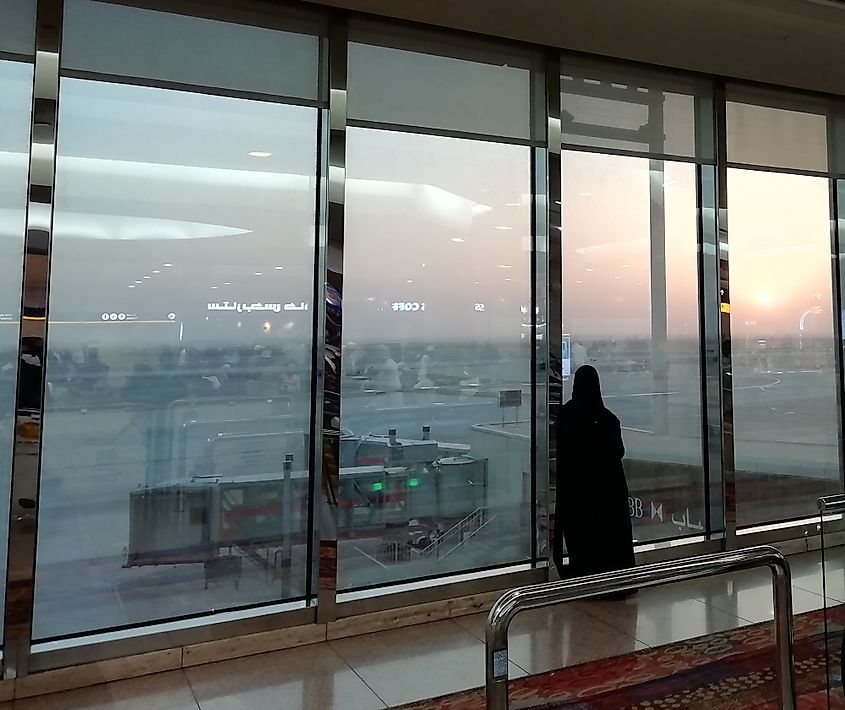
King Fahd Airport, the world's biggest airport by size, is an impressive airport located in Dammam, Saudi Arabia. Although the airport property covers about 776 square kilometers, the airport building sits on 36.8 square kilometers of land. Its construction began in 1983 and was completed on November 28, 1999. It served as a US airbase during the Gulf War. King Fahd Airport has three terminal buildings, with the main terminal sitting on 3.42 million square miles of land. It is used by over 10 million passengers annually, making it Saudi’s third-largest airport by passenger traffic.
2. Denver International Airport (DEN) - 135.71 km2
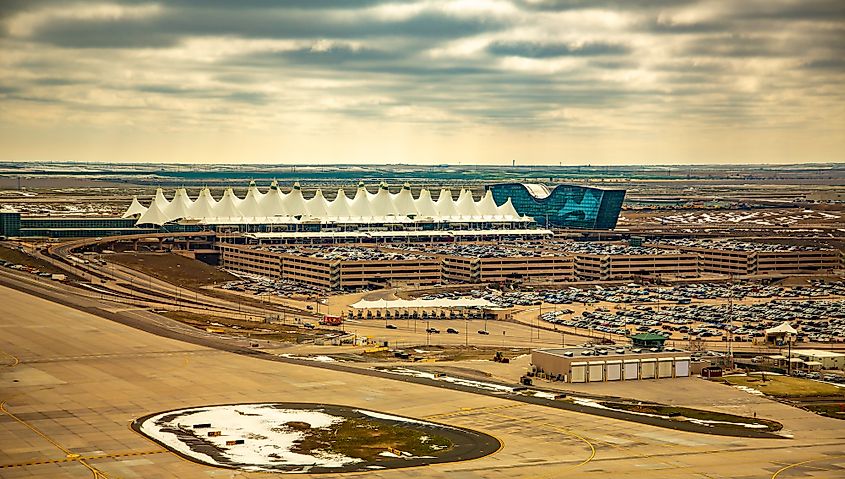
Denver International Airport is North America’s largest airport by area, spanning 135.7 square kilometers. DEN was opened officially on February 28, 1995, and serves up to 215 destinations. Its construction cost an equivalent of $8.1 billion today. One of its runways, 16R/34L, is the world’s 7th longest and North America’s longest runway.
3. Dallas/Fort Worth International Airport (DFW) - 69.63 km2

DFW airport is North America’s second-largest airport by area and the world’s 11th busiest by passenger traffic. It is located between Fort Worth and Dallas and occupies 69.6 square kilometers. Opened in September 1973, DFW Airport has its ZIP Code, emergency services, fire protection unit, and police. It has five terminals but can accommodate eight additional terminals. In 2019, the airport served 75 million passengers, the highest number in its history.
4. Orlando International Airport (MCO) - 53.83 km2
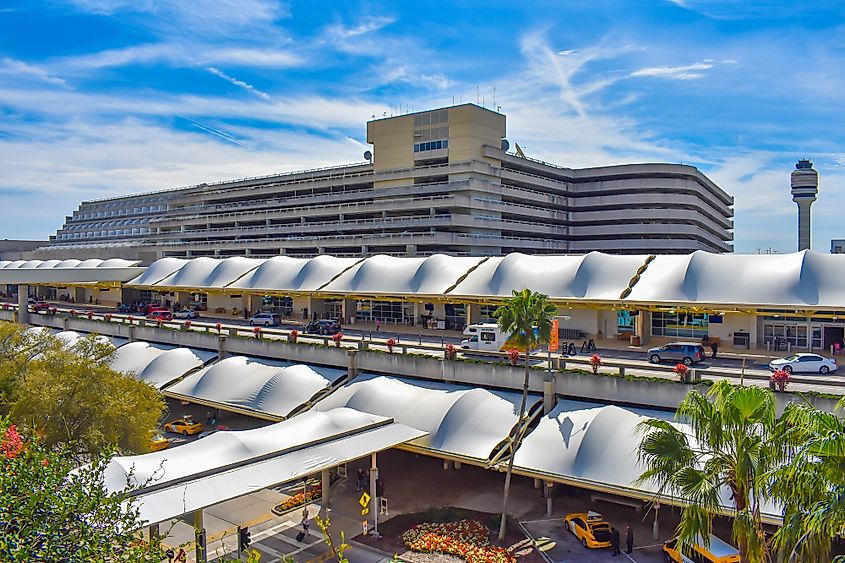
Orlando International Airport is situated about 6 miles away from Orlando, Florida. It is the state's busiest airport, serving over 850 daily flights and 135 destinations. The airport occupies 53.8 square kilometers and started operating in 1942 as a US Army Airforce facility. However, airline flights began using the facility in 1961 after the US and the City of Orland reached an agreement on its use. In 2019, the airport handled 50.6 million passengers.
5. Washington Dulles International Airport - 48.56 km2

Dulles Airport is one of the major airports in the Washington-Baltimore region. It is located in Fairfax and Loudoun Counties in Virginia and about 42 kilometers from Washington DC. The airport is named after Joh Dulles, the US’s 52nd Secretary of State, and was opened officially in 1962. Dulles Airport sits on 52.6 square kilometers of land and serves over 24 million passengers annually and more than 125 destinations.
6. Beijing Daxing International Airport (PKX) - 47 km2

Beijing Daxing International Airport.
BDIA in China is the world’s 6th largest airport by size. The airport, nicknamed “Starfish,” is located on the Beijing-Langfang border, 65 km south of the Beijing Capital International Airport. Its construction commenced in December 2014 and was completed on June 30, 2019, with the official opening on September 25, 2019. The airport’s construction cost $17 billion. It features a 7.5 million square feet terminal sitting on an 18-square mile of land. The facility can handle over 100 million passengers annually. It will be the world’s busiest airport if its capacity is utilized fully.
7. George Bush Intercontinental Airport (IAH) - 44.51 km2

George Bush Intercontinental Airport occupies 44.5 square kilometers. It is located about 37 square kilometers north of Huston, Texas, and is the state’s second busiest airport. It served about 45.3 million passengers in 2019, making it the world’s 47th busiest airport. IAH was opened in 1969 and has five terminals. Initially known as Houston Intercontinental Airport, It was renamed in honor of George H. W. Bush in 1997.
8. Shanghai Pudong International Airport (PVG) - 39.88 km2

Shanghai Pudong International Airport is located 30 kilometers from Shanghai and occupies 39.9 square kilometers. It is one of two airports in Shanghai and mainly serves international passengers. Opened on October 1, 1999, the airport has two terminals, with plans for an additional one underway. Pudong Airport has an annual capacity of 60 million passengers and serves over 210 destinations.
9. Cairo International Airport (CAI) - 36.25 km2
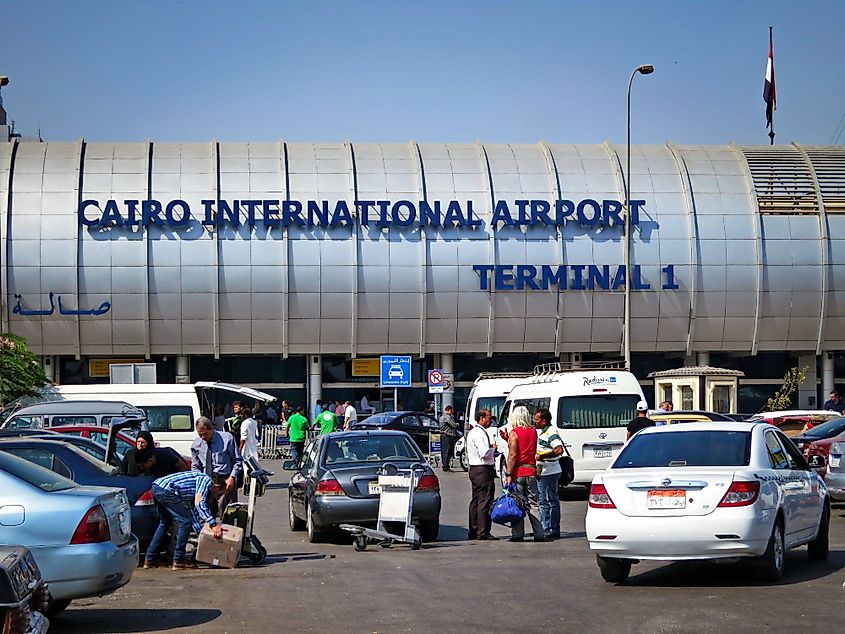
Cairo International Airport is Africa’s biggest and second-busiest airport. It is Nile Air's and EgyptAir's primary hub, occupying 37 square kilometers in the Heliopolis. It is located 15 kilometers east of Cairo and has three main terminals and a seasonal flight terminal. It served as US Air Force Base until 1963 when Civil Aviation took over its operations. In 2017, 15 million passengers passed through the airport.
10. Suvarnabhumi Airport (BKK) - 32.4 km2

Suvarnabhumi Airport is the biggest airport in Southeast Asia, covering 32.4 square kilometers. The name “Suvarnabhumi” translates to “land of gold.” It is located in Bang Phil in Samut Prakan Province, Bangkok, Thailand, and was opened officially on September 28, 2006. The airport, whose construction cost $5 billion, has two runways that can serve 64 flights in one hour. It has a capacity of 45 million passengers per year.
The US Is Home To Most Of The Biggest Airports
As observed, 5 of the 10 biggest airports in the world are in the United States. Denver International Airport is the country’s biggest and world’s second-largest airport by area, covering 135.7 square kilometers. Also, the US is home to four of the ten world’s busiest airports by passenger traffic, including the world's busiest, Hartsfield–Jackson Atlanta International Airport.
The 10 Biggest Airports In The World
| Rank | Airport | Area (in sq. km) | Country |
|---|---|---|---|
| 1 | King Fahd International Airpor | 776 | Saudi Arabia |
| 2 | Denver International Airport | 135.71 | United States |
| 3 | Dallas/Fort Worth International Airport | 69.63 | United States |
| 4 | Orlando International Airport | 53.83 | United States |
| 5 | Washington Dulles International Airport | 48.56 | United States |
| 6 | Beijing Daxing International Airport | 47 | China |
| 7 | George Bush Intercontinental Airport | 44.51 | United States |
| 8 | Shanghai Pudong International Airport | 39.88 | China |
| 9 | Cairo International Airport | 36.25 | Egypt |
| 10 | Suvarnabhumi Airport | 32.4 | Thailand |
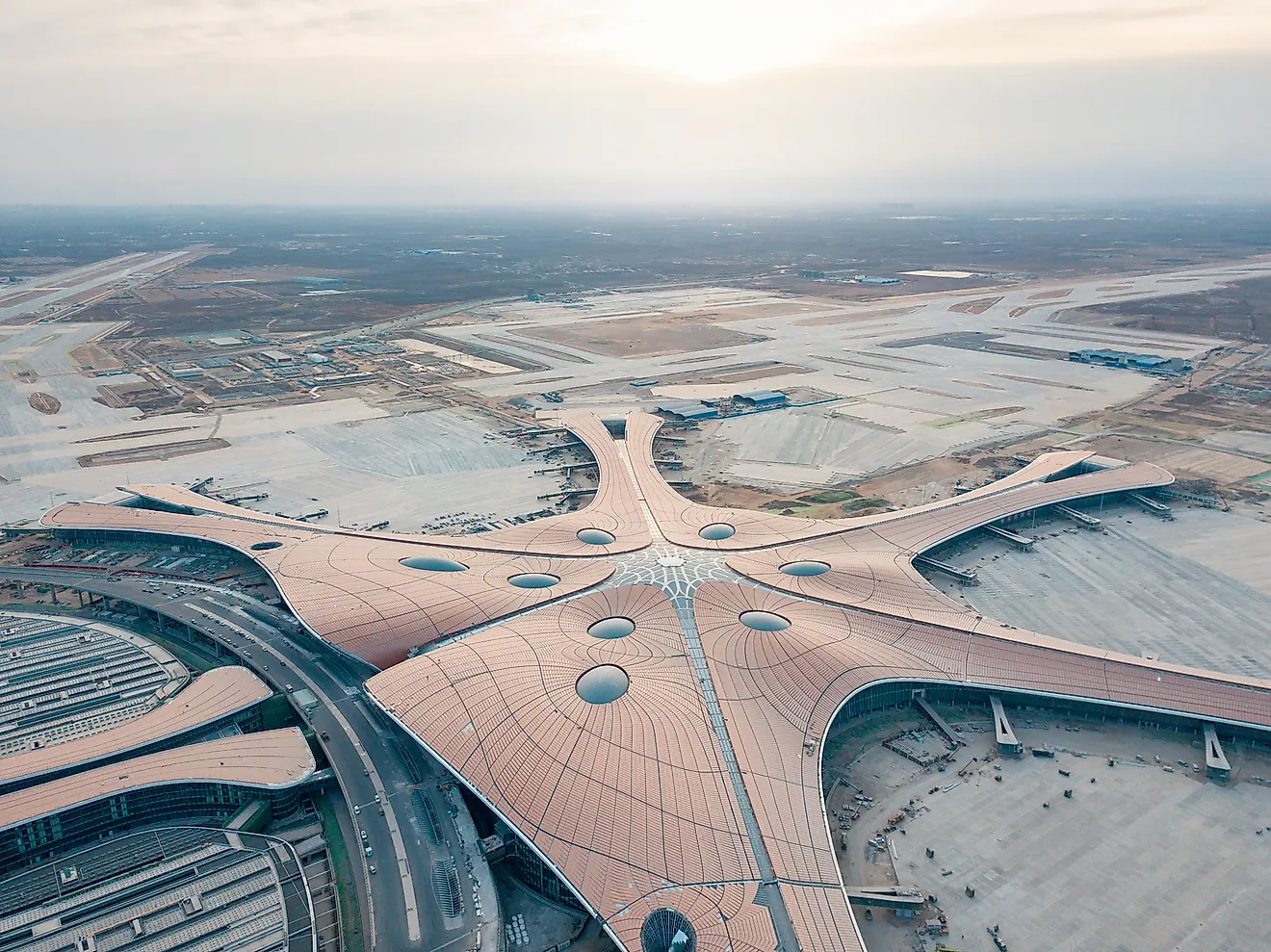

No comments:
Post a Comment